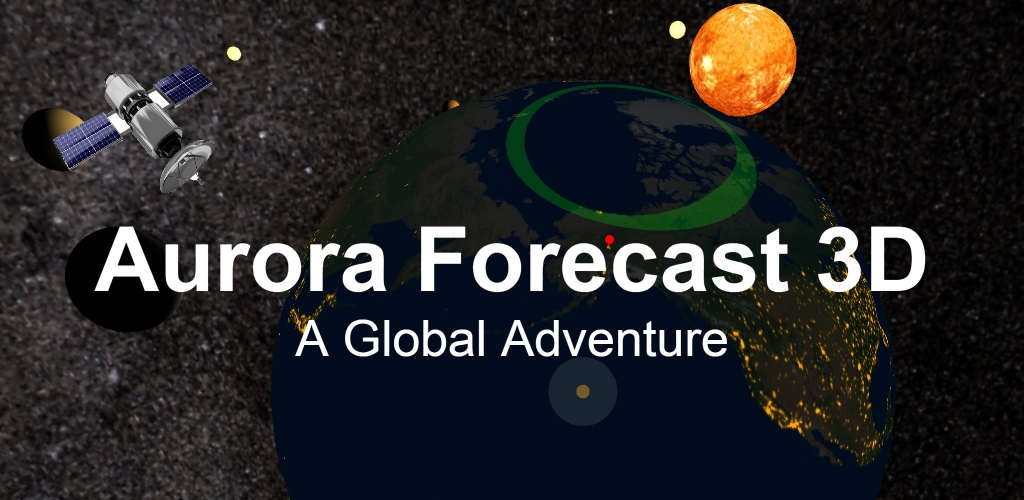| ☰ Menu | Forecast features |

An Aurora Compass is included that shows where the auroral oval, the Moon and the Sun are located as you look up at the sky from your location. The phase and age of the Moon is also visualized in the compass. By zooming out in the 3D view port, satellites, stars and planets appear in their orbits around the Sun.
- Solar illumination of the Earth and the Moon.
- Aurora oval size and location in real time [1,2].
- Dayside location of the red colored Cusp.
- Forecasts based on predicted NOAA-SWPC Kp index.
- Color scaled Kp speedometer.
- Aurora Compass sky view display.
- Editable station / location list.
- Go to animation.
- Right Ascension and Declination of the Moon, Sun and 8 planets [3].
- Age of the Moon including the phase.
- Includes a 2.4 million star map [4].
- City light texture [5].
- Earth, Sun and Moon textures [6,7].
- Skyview module to track planets, stars and satellites [8].
- 3-day space weather condition forecast as news ticker.
- 3-day long term Kp summary plot.
- Two-Line Element (TLE) satellite orbit calculations [9].
- Apparent Solar Time (AST).
- Skyview navigation.
- Laser Star pointer to 3D view port constellations [10].
- Sounding rocket trajectories.
- Sun and Moon daily elevation plots with rise and set time.
- Epoch selection for magnetic pole position[11].
- Zhang and Paxton oval precipitation[12].
- Ovals based on polar orbiting satellites data[13].
- Target links Wikipedia, N2YO, Open Street Map, NOAA and YR
- Boreal Aurora Camera Constellation (BACC) links[14].
- Sky colors by the Perez formula[15,16].
- Loop mode for output to a web server (Windows, OSX and Linux).
- Earth shadow height calculation in twilight conditions[17].
- Youtube demonstration.
Search for "Aurora Forecast 3D" by Fred Sigernes on Google Play (Android) or App Store (iOS).
Please read the Release notes before installation.
|
|
||
| Plattforms | Link (*.zip;.tar.gz) | Mb |
| Windows 32-bit | AuroraForecast3D_Win32 | 13 |
| Windows 64-bit | AuroraForecast3D_Win64 | 14 |
| Apple OSX 64-bit | AuroraForecast3D_OSX64 | 21 |
| Ubuntu Linux 64-bit | AuroraForecast3D_Linux | 20 |
Installation: Unpack the compressed file. Place the executable file in any directory of choice and just run it. Note that the executable file is not signed. You will need to trust it as an unknown 3rd party program. Setup .txt files will be generated automatically and located in your Documents folder. The program is tested on Windows 7-11, macOS Venture version 13.3.1, Debian 8 and Ubuntu 22.04.2 LTS (Linux Readme).
IMPORTANT! The application is compiled with Delphi Firemonkey RAD studio. The hardware requirements is found here. Please check your system before you try to install the program.

View demo of app
[2] Starkov G. V., Mathematical model of the auroral boundaries, Geomagnetism and Aeronomy, 34 (3), 331-336, 1994.
[3] P. Schlyter, How to compute planetary positions, http://stjarnhimlen.se/, Stockholm, Sweden.
[4] Bridgman, T. and Wright, E., The Tycho Catalog Sky map- Version 2.0, NASA/Goddard Space Flight Center Scientific Visualization Studio, http://svs.gsfc.nasa.gov/3572, January 26, 2009.
[5] The Visible Earth catalog, http://visibleearth.nasa.gov/, NASA/Goddard Space Flight Center, April-October, 2012.
[6] T. Patterson, Natural Earth III - Texture Maps, http://www.shadedrelief.com, October 1, 2016.
[7] Nexus - Planet Textures, http://www.solarsystemscope.com/nexus/, January 4, 2013.
[8] Hoffleit, D. and Warren, Jr., W.H., The Bright Star Catalog, 5th Revised Edition (Preliminary Version), Astronomical Data Center, NSSDC/ADC, 1991.
[9] Vallado, David A., Paul Crawford, Richard Hujsak, and T.S. Kelso, Revisiting Spacetrack Report #3, AIAA/AAS-2006-6753, https://celestrak.com, 2006.
[10] Christensen L.L., M. Andre, B. Rino, R.Y. Shida, J. Enciso, G.M. Carillo, C. Martins, and M.R. D'Antonio, The Constellations, The International Astronomical Union (IAU), https://iau.org, 2019.
[11] Tsyganenko, N. A., Secular drift of the auroral ovals: How fast do they actually move?, Geophysical Research Letters, 46, 3017-3023, 2019.
[12] Zhang Y., and L. J. Paxton, An empirical Kp-dependent global auroral model based on TIMED/GUVI data, J. Atm. Solar-Terr. Phys., 70, 1231-1242, 2008.
[13] M. J. Breedveld, Predicting the Auroral Oval Boundaries by Means of Polar Operational Environmental Satellite Particle Precipitation Data, Master thesis, Department of Physics and Technology, Faculty of Science and Technology, The Arctic University of Norway, June 2020.
[14] The Boreal Aurora Camera Constellation (BACC), kho.unis.no/doc/BACC.pdf, December 18, 2020.
[15] Perez R., J.M. Seals, and P. Ineichen, An all-weather model for sky luminance distribution, Solar Energy, 1993.
[16] Preetham A.J., P. Shirley and B. Smith, A practical analytic model for daylight, Computer Graphics, (SIGGRAPH '99 Proceedings), 91-100, 1999.
[17] Lloyd, K. H., Calculation of the effective height of the Earth's shadow, Planet. Space. Sci., 16, 1071-1073, 1968.